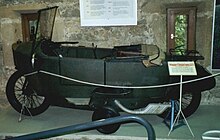Winkler (car brand)
| Gustav Winkler | |
|---|---|
| legal form | |
| founding | 1926 or 1927 |
| resolution | 1929 |
| Seat | Oberndorf am Neckar , Berlin , Germany |
| management | Gustav Winkler |
| Branch | Automobile manufacturer |
Gustav Winkler was a German manufacturer of automobiles from Oberndorf am Neckar , later Berlin .
Company history
The Berlin designer Gustav Winkler developed a single-track car in 1920 . The weapons manufacturer Mauser-Werke AG took over the design, developed it further and launched it on the market in 1921 as the Mauser single-track car 2/6 HP . When Mauser ceased production in 1926 or 1927, Gustav Winkler acquired the remainder of the parts, developed the vehicle further, and marketed it as a Winkler single-track car . Production initially took place in part of the Mauser factory in Oberndorf am Neckar, and later in Berlin.
Production ended in 1929.
vehicle
It was a car on two wheels, one at the front, one at the back, as well as two side support wheels that were folded up while driving. The engine was located under the rear seat and drove the rear wheel via a chain. The vehicle offered space for two people in a row.
Mauser single-track car 2/6 hp
The water-cooled single-cylinder engine with a displacement of 510 cm³ was a side-controlled T-head engine and developed 6.0 hp at 3200 rpm. This was installed in the first 200 copies. The crankshaft was on roller and slide bearings, the connecting rod was on roller bearings, the three-speed gearbox and the steel disk clutch were built into the engine housing. The engine was lubricated with a pressure pump. The cooler for the thermosiphon cooling is installed on the front of the car. The engine is started with a kick starter. Another engine, also built by Mauser, had overhead valves and a displacement of 573 cc.
chassis
The box frame was made of sheet steel and provided with forks for the front and rear wheels. These were equipped with coil springs and air cushions. The mechanical brakes acted on the rear wheel, with the handbrake acting as a band brake on the outside of the brake drum and the footbrake acting as an inner shoe brake. The wheels were 710 × 90, the retractable support wheels had a diameter of 15 inches. The vehicle, with a wheelbase of 2230 mm, was 3.0 m long, 1.20 m wide and 1.10 m high. The curb weight was 295 kg, the payload was 200 kg. (Different dimensions are given in the various sources). The spoked wheels are interchangeable, the support wheels, designed as disk wheels, were raised with an internal lever while driving. The body is made of plywood covered with artificial leather and has a door on the left. The rear fairing could be completely removed for maintenance work. The windshield, which extended across the width of the car, was attached to the steering linkage.
Winkler single-track car type EA 2
In 1926, Winkler took over the production of the single-lane car and revised the design. The wheelbase was shortened by twelve cm and the vehicle lowered by ten cm. This resulted in improved driving characteristics. A water-cooled single cylinder engine with 510 cm³ displacement and 10 HP was installed as drive. There were also vehicles with an air-cooled two-cylinder boxer engine from BMW with an output of 6 hp.
Motorization
There are different details about the engine. One source mentions a single cylinder engine developed by Mauser with 85 mm bore , 90 mm stroke , 510 cm³ displacement and 10 hp , but does not state whether Winkler continued to use this engine. An older source states that from 1927 Winkler used an air-cooled two - cylinder boxer engine with a displacement of 493 cm³ and 6 hp. An even older source mentions a single-cylinder engine with OHV valve control , 90 mm bore, 90 mm stroke, 573 cm³ displacement and 6 HP output, also developed by Mauser, which Mauser finally used; but also does not state whether Winkler used this engine. A fourth source mentions a single-cylinder engine from BMW with a displacement of 500 cm³ and an output of 10 hp.
A vehicle is in the Oberndorf local history museum in Oberndorf. Another was in 1998 in the German Car Museum in Langenburg Castle in Langenburg issued.
literature
- Kresimir Majer, Michael Hundt: Well blossomed. In: Oldtimer-Markt , edition 8/2009, p. 166.
- Karl Reese: The Mauser single-track car. In: Automobil- und Motorradchronik, issue 4/1978, p. 23.
- Erwin Tragatsch : Mauser single-track car. In: Oldtimer-Markt, issue 12/1984, p. 56.
- Werner Oswald : German Cars 1920–1945. Motorbuch Verlag, Stuttgart 199, ISBN 3-87943-519-7 , p. 188.
- Harald H. Linz, Halwart Schrader : The International Automobile Encyclopedia . United Soft Media Verlag, Munich 2008, ISBN 978-3-8032-9876-8 , chapter Winkler.
- Peter Mergelkuhl: A ship will come. In: Oldtimer-Markt, edition 11/2000, p. 20.
- Mauser single track car. The small caliber. In: Auto Bild Klassik , issue 4/2012, p. 78.
Web links
Individual evidence
- ↑ a b c d Karl Reese: The Mauser single-track car. In: Automobil- und Motorradchronik, issue 4/1978, p. 23.
- ↑ a b c d e f Erwin Tragatsch: Mauser single-track car. In: Oldtimer-Markt, issue 12/1984, p. 56.
- ↑ a b Kresimir Majer, Michael Hundt: Well blossomed. In: Oldtimer-Markt , edition 8/2009, p. 166.
- ↑ a b Harald H. Linz, Halwart Schrader : The International Automobile Encyclopedia . United Soft Media Verlag, Munich 2008, ISBN 978-3-8032-9876-8 , chapter Winkler.
- ↑ a b Brochures from the single-track car (accessed on September 2, 2014)



